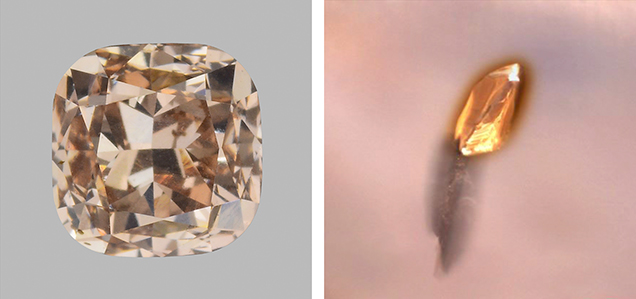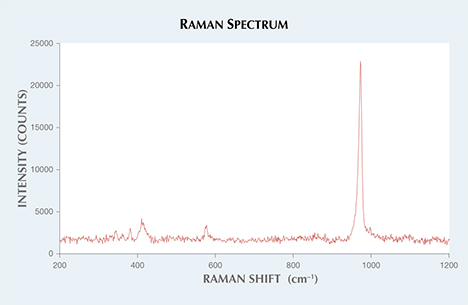Diamond Inclusion with Radiation Halo

Radiation is known to impart green or brown coloration to diamond. This effect most commonly appears as colored spots, presumably where radioactive mineral grains settled against the diamond for an extended period. Circulation of radioactive groundwater may contribute to a “skin” with more evenly distributed color. In either case, the radiation comes from an external source. GIA’s New York lab recently examined a 0.49 ct Fancy pink brown diamond containing an inclusion with a brown radiation stain in the form of a halo (figure 1). In this case, the radiation originated from the inclusion itself.
Because the inclusion is completely enclosed within the diamond, the material must have been trapped during diamond growth in the mantle. Raman spectroscopy (figure 2) revealed the inclusion to be monazite, (Ce,La,Nd,Th)PO4, a mineral capable of carrying significant amounts of radioactive thorium. Xenotime, YPO4, a similar rare earth phosphate, has also been reported as an inclusion in diamond with a radiation stain (Fall 2014 Lab Notes, pp. 237–238), but that inclusion was interpreted as epigenetic.

Monazite is very rarely reported as an inclusion in diamond. It is not part of the common mineral assemblage of peridotitic or eclogitic mantle host rocks. Instead, a rare earth element–enriched phosphate like monazite could be attributed to carbonatitic fluid or melt that infiltrated the host rocks and contributed to diamond growth. Monazite found within peridotite mantle xenoliths has also been ascribed to carbonatitic metasomatism (R.L. Rudnick et al., “Carbonatite metasomatism in the northern Tanzanian mantle: Petrographic and geochemical characteristics,” Earth and Planetary Science Letters, Vol. 114, No. 4, 1993, pp. 463–475). Other phosphate minerals, chiefly apatite, can be found as a component of the fluid microinclusions that characterize so-called fibrous diamond. Diamond-forming fluids or melts are believed to be an important source of incompatible elements that may re-enrich the otherwise depleted refractory lithospheric mantle.



